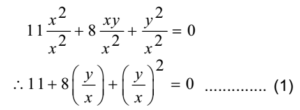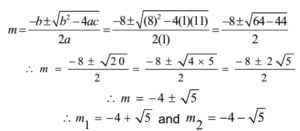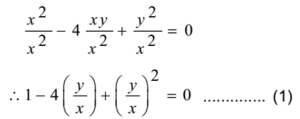Science > Mathematics > Pair of Straight Lines > Separate Equations of Lines (Auxillary Equation Method)
In this article, we shall study to find separate equations of lines from a combined or joint equation of pair of lines by auxiliary equation method.
Algorithm:
- Check if lines exist. use the same method used in the case to find the nature of lines. Proceed further if lines exist.
- Divide both sides of the equation by x2.
- Simplify the equation and substitute y/x = m in it.
- Find two roots m1 and m2 of quadratic equation in m
- Find separate equations of lines by y = m1 x and y = m2x
- Note that this method is applicable to any problem.
Example 01:
- Obtain the separate equations of the lines represented by 11x2 + 8xy + y2 = 0
- Solution:
The given joint equation is 11x2 + 8xy + y2 = 0
Dividing both sides of the equation by x2

The equation of a line passing through the origin is of the form y = mx
Substituting y/x = m in equation (1) we get
11 + 8m + m2 = 0
m2 + 8m + 11 = 0
This is a quadratic equation in m and has two roots say m1 and m2
which gives slopes of the two lines represented by the joint equation.
a = 1, b = 8, c = 11
The roots are given by

The equation of the first line is
y = m1x
∴ y = (-4 + √5) x
∴ y = – (4 – √5) x
∴ (4 – √5) x + y = 0
The equation of the second line is
y = m2x i.e. i.e.
∴ y = (-4 – √5) x
∴ y = – (4 + √5) x
∴ (4 + √5) x + y = 0
Ans: The separate equations of the lines are (4 – √5) x + y = 0 and (4 + √5) x + y = 0
Example 02:
- Obtain separate equations of lines represented by joint equation x2 – 4xy + y2 = 0.
- Solution:
The given joint equation is x2 – 4xy + y2 = 0
Dividing both sides of the equation by x2

The equation of a line passing through the origin is of the form y = mx
Substituting y/x = m in the equation (1) we get
1 – 4m + m2 = 0
∴ m2 – 4m + 1= 0
This is a quadratic equation in m and has two roots say m1 and m1
which gives slopes of the two lines represented by the joint equation.
a = 1, b = -4, c = 1
The roots are given by

The equation of the first line is
y = m1x
∴ y = (2 + √3) x
∴ (2 + √3) x – y = 0
The equation of the second line is
y = m2x
∴ y = (2 – √3) x
∴ (2 – √3) x – y = 0
Ans: The separate equations of the lines are (2 + √3) x – y = 0 and (2 – √3) x – y = 0
Example 03:
- Obtain separate equations of lines represented by joint equation 22x2 – 10xy + y2 = 0.
Solution:
The given joint equation is 22x2 – 10xy + y2 = 0.
Dividing both sides of the equation by x2

The equation of a line passing through the origin is of the form y = mx
Substituting y/x = m in the equation (1) we get
22 – 10m + m2 = 0
∴ m2 – 10m + 22= 0
This is a quadratic equation in m and has two roots say m1 and m1
which gives slopes of the two lines represented by the joint equation.
a = 1, b = – 10, c = 22
The roots are given by

The equation of the first line is
y = m1x
∴ y = (5 + √3) x
∴ (5 + √3) x – y = 0
The equation of the second line is
y = m2x
∴ y = (5 – √3) x
∴ (5 – √3) x – y = 0
Ans: The separate equations of the lines are (5 + √3) x – y = 0 and (5 – √3) x – y = 0
Example 04:
- Obtain separate equations of lines represented by joint equation x2 + 2xy – y2 = 0.
- Solution:
The given joint equation is x2 + 2xy – y2 = 0
Dividing both sides of the equation by x2

The equation of a line passing through the origin is of the form y = mx
Substituting y/x = m in the equation (1) we get
1 + 2m – m2 = 0
∴ m2 – 2m – 1= 0
This is a quadratic equation in m and has two roots say m1 and m1
which gives slopes of the two lines represented by the joint equation.
a = 1, b = – 2, c = -1
The roots are given by

The equation of the first line is
y = m1x
∴ y = (1 + √2) x
∴ (1 + √2) x – y = 0
The equation of the second line is
y = m2x
∴ y = (1 – √2) x
∴ (1 – √2) x – y = 0
Ans: The separate equations of the lines are (1 + √2) x – y = 0 and (1 – √2) x – y = 0
Example 05:
- Obtain separate equations of lines represented by joint equation 2x2 + 2xy – y2 = 0.
Solution:
The given joint equation is 2x2 + 2xy – y2 = 0
Dividing both sides of the equation by x2

The equation of a line passing through the origin is of the form y = mx
Substituting y/x = m in the equation (1) we get
2 + 2m – m2 = 0
∴ m2 – 2m – 2= 0
This is a quadratic equation in m and has two roots say m1 and m1
which gives slopes of the two lines represented by the joint equation.
a = 1, b = – 2, c = -2
The roots are given by

The equation of the first line is
y = m1x
∴ y = (1 + √3) x
∴ (1 + √3) x – y = 0
The equation of the second line is
y = m2x
∴ y = (1 – √3) x
∴ (1 – √3) x – y = 0
Ans: The separate equations of the lines are (1 + √3) x – y = 0 and (1 – √3) x – y = 0
Example 06:
- Obtain separate equations of lines represented by joint equation x2 + 2(tanα) xy – y2 = 0.
- Solution:
The given joint equation is x2 + 2(tanα) xy – y2 = 0
Dividing both sides of the equation by x2

The equation of a line passing through the origin is of the form y = mx
Substituting y/x = m in the equation (1) we get
1 + 2tanα m – m2 = 0
∴ m2 – 2tanα m – 1= 0
This is a quadratic equation in m and has two roots say m1 and m1
which gives slopes of the two lines represented by the joint equation.
a = 1, b = – 2tanα, c = -1
The roots are given by

The equation of the first line is
y = m1x
∴ y = (tanα + secα) x
∴ (tanα + secα) x – y = 0
The equation of the second line is
y = m2x
∴ y = (tanα – secα) x
∴ (tanα – secα) x – y = 0
Ans: The separate equations of the lines are (tanα + secα) x – y = 0 and (tanα – secα) x – y = 0
Example 07:
- Obtain separate equations of lines represented by joint equation x2 + 2(cosecα) xy + y2 = 0.
- Solution:
The given joint equation is x2 + 2(cosecα) xy + y2 = 0.
Dividing both sides of the equation by x2

The equation of a line passing through the origin is of the form y = mx
Substituting y/x = m in the equation (1) we get
1 + 2cosecα m + m2 = 0
∴ m2 + 2cosecα m + 1= 0
This is a quadratic equation in m and has two roots say m1 and m1
which gives slopes of the two lines represented by the joint equation.
a = 1, b = 2cosecα, c = 1
The roots are given by

The equation of the first line is
y = m1x
∴ y = (- cosec α + cot α) x
∴ y = – (cosec α – cot α) x
∴ (cosec α – cot α) x – y = 0
The equation of the second line is
y = m2x
∴ y = (- cosec α – cot α) x
∴ y = – (cosec α + cot α) x
∴ (cosec α + cot α) x – y = 0
Ans: The separate equations of the lines are (cosec α – cot α) x – y = 0 and (cosec α + cot α) x – y = 0